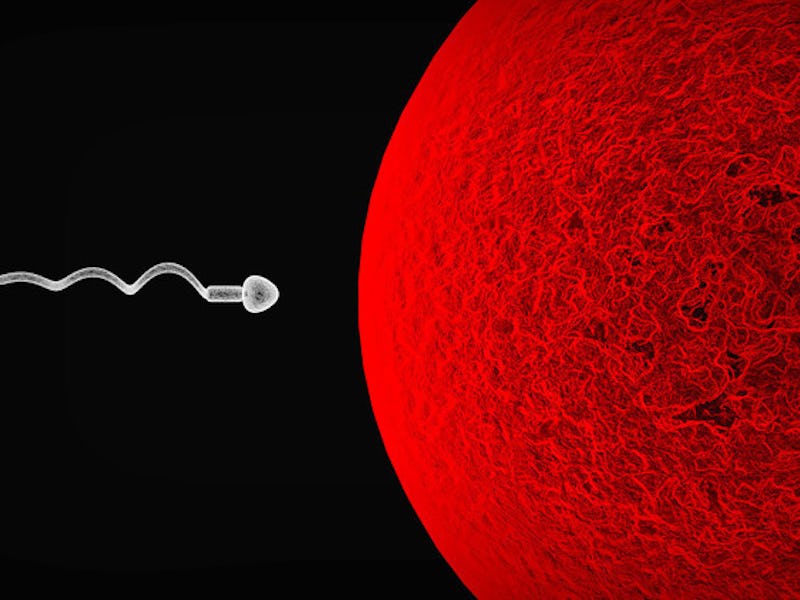Human Sperm Could Survive Trips Into Space, Study Suggests
"It's not unreasonable to start thinking about the possibility of reproduction beyond the Earth."

As humans stand on the verge of becoming a multi-planetary species, a major question also hangs in the air: Will we last more than a single generation in space?
If we’re going to establish camps on Mars or send humans to distant exoplanets, we’ll need to reckon with the reality that these human space travelers will be having babies in space or on other planets — especially on missions that could last multiple human lifetimes. In order to best prepare for these possible eventualities, scientists have started exploring all the unknowns surrounding human reproduction beyond Earth, starting with whether sperm cells can survive beyond our planet’s gravity.
In a presentation on Sunday, Spanish scientists showed the results of an experiment in which frozen human sperm samples were given a ride in microgravity. After a series of flight maneuvers that simulated the effects of microgravity, the sperm returned to Earth, where they were tested for a range of quality measures.
After their brief trip to microgravity, the sperm were about as healthy as sperm samples that had stayed on the ground.
Montserrat Boada, Ph.D., a senior clinical embryologist at Dexeus Women’s Health in Barcelona and the study’s lead author, presented the findings at the 35th annual meeting of the European Society of Human Reproduction and Embryology.
“If the number of space missions increases in the coming years, and are of longer duration, it is important to study the effects of long-term human exposure to space in order to face them,” said Boada in a statement.
“It’s not unreasonable to start thinking about the possibility of reproduction beyond the Earth.”
The sperm samples were loaded into a CAP 10 aircraft, which executed parabolic maneuvers to simulate the effects of microgravity.
To conduct this research, sperm from 10 healthy donors took a ride in an aerobatic training aircraft — a CAP 10 to be specific.
The small plane completed 20 parabolic arcs that created about 8 seconds of microgravity each. In a parabolic maneuver, a plane flies up at a 45° angle then down again at the same angle, creating a short period of near-weightlessness in the middle.
If this sounds familiar, it may be because NASA has used a similar technique to get astronauts familiar with the feelings they’ll experience in microgravity, aboard the plane that’s affectionately named the Vomit Comet.
After the sperm samples returned from their foray into weightlessness, Boada’s team analyzed them for several measures of health, including concentration, motility (swimming ability), vitality (how many lived or died from ruptured cell membranes), morphology, (shape), and DNA fragmentation.
They report that when measuring DNA fragmentation and vitality, the sperm samples that had experienced microgravity showed no significant changes when compared to the control group that had stayed on the ground. As far as sperm concentration and motility, they reported that the zero-G sperm returned at 90 percent the level of the control group — a pretty minor decrease that Boada says could be due to individual factors related to the health of the sperm.
The team’s report does not note the results for morphology.
This study is a proof-of-concept that looks at just one of the many crucial factors influencing human reproduction in space.
A Very Short Trip
The time the sperm spent in microgravity conditions wasn’t very long, presumably a factor that was limited by the use of an aircraft rather than actually going into space.
Additionally, the study didn’t address the potential effects of space radiation on human sperm, one of the primary obstacles keeping humans from going to Mars — and a factor whose effects get worse the longer you’re exposed to it.
Inverse has reached out to the study’s authors about this issue, and we will update this article when we hear back.
These are no ordinary juvenile mice. These "space pups" were produced by freeze-dried sperm that spent nine months aboard the ISS.
This study builds on previous research in which a team reared healthy mice from freeze-dried sperm that was aboard the International Space Station for 288 days. In that case, though, the researchers specified that freeze-drying sperm to preserve them — rather than using cryopreservation — might be more well suited for livestock breeding in space than for human reproduction.
Boada did note in her statement that the team used frozen sperm to minimize the potential effects of radiation during the experiment, since fresh samples are known to be more susceptible to damage from radiation. Future studies will be necessary to determine the combined effects of radiation and microgravity on human sperm.
“So our first step was to investigate gravity conditions and frozen sperm samples,” she said. “Our best option will be to perform the experiment using real spaceflight, but access is very limited.”